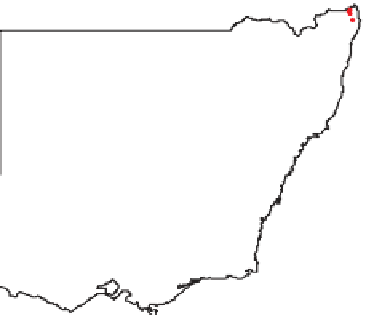Geography Reference
In-Depth Information
Figure 7.13. Nash
Sutcliffe
efficiency (NSE) of quantiles
of the FDC obtained from
four regional models in
south-east Australia. Three
colours denote three
categories based on the range
of within-catchment NSE
(red: above 0.75; green:
between 0.5 and 0.75; blue:
below 0.5). From Li et al.
(
2010
).
-
a) Index model
b) Linear regression
c) Nearest catchment
d) HYD similarity
250 km
and (ii) the definition of an allocation rule to assign
ungauged sites to a group. In the European FRIEND
(1989)
study, dimensionless daily FDCs were averaged
within pooling groups of catchments. A similar approach
was used by Hughes and Smakhtin (
1996
) and Smakhtin
et al.
(1997)
to construct seasonal FDCs for one of the
primary drainage regions of South Africa, and by Castel-
larin et al.(
2004a
) to construct six dimensionless daily
FDCs for six hydrologically similar pooling groups of
sites (see also
Chapter 11
, Case studies). Ganora et al.
(
2009
) presented the construction of regional dimension-
less FDC, in which the pooling group of gauged sites is
identified through cluster analysis using a distance metric
that quantifies the dissimilarity between pairs of curves,
and the FDC of each cluster is identified as the mean
normalised duration curve. Minimum catchment elevation
and, less importantly, mean hillslope length were found to
be the best explanatory variables for the grouping of
catchments in north-western Italy and Switzerland that
were part of the study by Ganora et al.(
2009
) and were
used to subdivide the study area into two homogeneous
regions (
Figure 7.14
). The minimum catchment elevation
could be interpreted as a surrogate for the seasonality of
flow regimes in the region, which is controlled by snow,
glaciers and precipitation regime in Alpine catchments as
opposed to lowland mixed regimes and the Apennine
-
Mediterranean bimodal regime in the south-east of the
region (with lower elevations). Similarly, in Nepal, Arora
et al.(
2005
) used elevation in their relationship for non-
dimensional flow, since more variability happens at
higher elevations. Regime is controlled by snow, glaciers
and precipitation (of which elevation and area are surro-
gates), and the regime curve controls the FDC, as dis-
cussed in Section 7.2.
Croker et al.
(2003)
proposed a theoretical framework to
address the construction of FDCs in arid regions of the
world with ungauged ephemeral or intermittent streams.
They presented a regional model to estimate the probability
of zero/non-zero flows for Portuguese ungauged river
basins. The model estimates the probability of zero flows
as a function of the mean annual precipitation, as a surro-
gate of both geographical location and climatic conditions,
allowing the derivation of FDCs for ungauged river basins,
either ephemeral or perennial.
Parametric methods and rescaled FDC methods are
complementary. Parametric methods enable one to model
the entire curve, resulting in runoff estimates associated
with any duration of the FDC, but often more than three
















































































































































































































































































































































































































































































































































































































































































































































































































































































































































































































































































































































































































































































































































































































































































































































































































































































































































































































































































































































































































































































































































































































































































































































































































































































































































































































































































































Search WWH ::

Custom Search